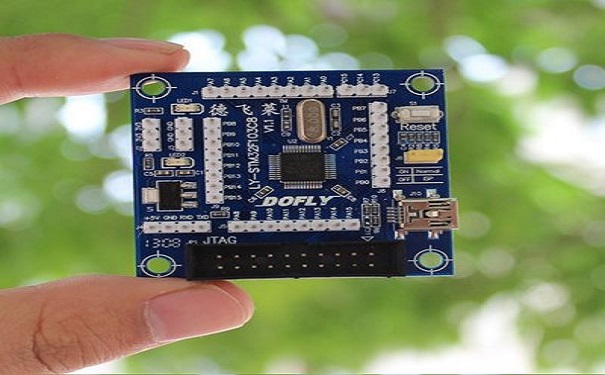A microcontroller (MCU for microcontroller unit, also MC, UC, or μC) is a small computer on a single VLSI integrated circuit (IC) chip. A microcontroller contains one or more CPUs (processor cores) along with memory and programmable input/output peripherals. Program memory in the form of ferroelectric RAM, NOR flash or OTP ROM is also often included on chip, as well as a small amount of RAM. Microcontrollers are designed for embedded applications, in contrast to the microprocessors used in personal computers or other general purpose applications consisting of various discrete chips. In modern terminology, a microcontroller is similar to, but less sophisticated than, a system on a chip (SoC). An SoC may connect the external microcontroller chips as the motherboard components, but an SoC usually integrates the advanced peripherals like graphics processing unit (GPU) and Wi-Fi interface controller as its internal microcontroller unit circuits. Microcontrollers are used in automatically controlled products and devices, such as automobile engine control systems, implantable medical devices, remote controls, office machines, appliances, power tools, toys and other embedded systems. By reducing the size and cost compared to a design that uses a separate microprocessor, memory, and input/output devices, microcontrollers make it economical to digitally control even more devices and processes. Mixed signal microcontrollers are common, integrating analog components needed to control non-digital electronic systems. In the context of the internet of things, microcontrollers are an economical and popular means of data collection, sensing and actuating the physical world as edge devices. Some microcontrollers may use four-bit words and operate at frequencies as low as 4 kHz for low power consumption (single-digit milliwatts or microwatts). They generally have the ability to retain functionality while waiting for an event such as a button press or other interrupt; power consumption while sleeping (CPU clock and most peripherals off) may be just nanowatts, making many of them well suited for long lasting battery applications. Other microcontrollers may serve performance-critical roles, where they may need to act more like a digital signal processor (DSP), with higher clock speeds and power consumption.

History
Background
The first multi-chip microprocessors, the Four-Phase Systems AL1 in 1969 and the Garrett AiResearch MP944 in 1970, were developed with multiple MOS LSI chips. The first single-chip microprocessor was the Intel 4004, released on a single MOS LSI chip in 1971. It was developed by Federico Faggin, using his silicon-gate MOS technology, along with Intel engineers Marcian Hoff and Stan Mazor, and Busicom engineer Masatoshi Shima.It was followed by the 4-bit Intel 4040, the 8-bit Intel 8008, and the 8-bit Intel 8080. All of these processors required several external chips to implement a working system, including memory and peripheral interface chips. As a result, the total system cost was several hundred (1970s US) dollars, making it impossible to economically computerize small appliances.
MOS Technology introduced its sub-$100 microprocessors in 1975, the 6501 and 6502. Their chief aim was to reduce this cost barrier but these microprocessors still required external support, memory, and peripheral chips which kept the total system cost in the hundreds of dollars.
Development
One book credits TI engineers Gary Boone and Michael Cochran with the successful creation of the first microcontroller in 1971. The result of their work was the TMS 1000, which became commercially available in 1974. It combined read-only memory, read/write memory, processor and clock on one chip and was targeted at embedded systems.
During the early-to-mid-1970s, Japanese electronics manufacturers began producing microcontrollers for automobiles, including 4-bit MCUs for in-car entertainment, automatic wipers, electronic locks, and dashboard, and 8-bit MCUs for engine control.
Partly in response to the existence of the single-chip TMS 1000,Intel developed a computer system on a chip optimized for control applications, the Intel 8048, with commercial parts first shipping in 1977.It combined RAM and ROM on the same chip with a microprocessor. Among numerous applications, this chip would eventually find its way into over one billion PC keyboards. At that time Intel's President, Luke J. Valenter, stated that the microcontroller was one of the most successful products in the company's history, and he expanded the microcontroller division's budget by over 25%.
Most microcontrollers at this time had concurrent variants. One had EPROM program memory, with a transparent quartz window in the lid of the package to allow it to be erased by exposure to ultraviolet light. These erasable chips were often used for prototyping. The other variant was either a mask programmed ROM or a PROM variant which was only programmable once. For the latter, sometimes the designation OTP was used, standing for "one-time programmable". In an OTP microcontroller, the PROM was usually of identical type as the EPROM, but the chip package had no quartz window; because there was no way to expose the EPROM to ultraviolet light, it could not be erased. Because the erasable versions required ceramic packages with quartz windows, they were significantly more expensive than the OTP versions, which could be made in lower-cost opaque plastic packages. For the erasable variants, quartz was required, instead of less expensive glass, for its transparency to ultraviolet light—to which glass is largely opaque—but the main cost differentiator was the ceramic package itself.
In 1993, the introduction of EEPROM memory allowed microcontrollers (beginning with the Microchip PIC16C84) to be electrically erased quickly without an expensive package as required for EPROM, allowing both rapid prototyping, and in-system programming. (EEPROM technology had been available prior to this time,but the earlier EEPROM was more expensive and less durable, making it unsuitable for low-cost mass-produced microcontrollers.) The same year, Atmel introduced the first microcontroller using Flash memory, a special type of EEPROM.Other companies rapidly followed suit, with both memory types.
Nowadays microcontrollers are cheap and readily available for hobbyists, with large online communities around certain processors.
 繁體(台灣)
繁體(台灣) 简体中文
简体中文 USA(English)
USA(English) Vietnam
Vietnam